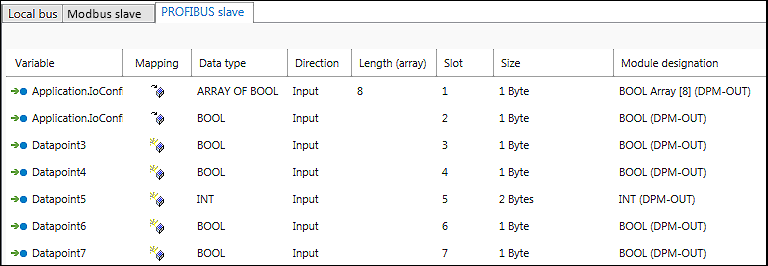PROFIBUS Data Point Configurator
When configuring the PROFIBUS slave, data points are created that are used for communication between the PROFIBUS slave and PROFIBUS master. The PROFIBUS slave can be an external device that is not configured in e!COCKPIT.
The configuration is done in the “PROFIBUS Slave” tab below the device in the Device Detail view. The following functions can be executed:
- Creation/Deletion of data points
- Mapping of data points to existing application variables (CODESYS configuration user interface)
- Creation of data points as new CODESYS variables (CODESYS configuration user interface); these can be addressed directly in the program editor.
- Export of the configuration in the form of a device description file (*.gsd or *.gsg).
The data points are shown in tabular form. Each column represents a property of the data point. After a data point is created, properties (interdependent) can be changed. The individual table cells serve as entry or selection windows.

Parameter | Description | |
|---|---|---|
Variable | Displays the data point name The name is always identical to the name of the application variable. | |
| The data point can be written. | |
| The data point can be read. | |
| The data point can be written or read. | |
Mapping | Displays which variable is new and which variable already exists: | |
| The variable is not yet available, is newly created and can then be used in the entire project. | |
| Uses an already existing variable for mapping | |
Data type | Displays the data type of the data point, as well as the application variable The following data types are supported: | |
• BOOL | • ARRAY OF BOOL | |
Direction | Indicates whether it is input data or output data | |
Input | The value of the variables is set exclusively via the bus and is readable in the program. | |
Output | The value of the variables is set in the program and is only readable from the outside. | |
Length (Array) | Displays the number of elements With simple data types (no arrays), the value is always set to 1. With arrays, the value can be changed. | |
Slot | Displays the slot's number Each data point is automatically assigned a slot. This cannot be changed. The data of a slot is always transmitted in a PROFIBUS telegram. This guarantees the consistency of the transferred data. | |
Size | Displays the size of the data point in bytes | |
Module designation | Displays the module name Each data point can be assigned a module name. If a user-defined name is not assigned, the name is generated from the data type and the number of elements. This is automatically updated with changes. A default name is also generated for deleted module names. | |
Right-clicking inside the table opens the context menu for adding (New/Create multiple/Duplicate), removing (Delete), rearranging (Up/Down) or renaming (Rename) data points.

These commands are also provided in the menu ribbon. The menu ribbon also provides commands for creating and duplicating several data points. Click the [Export] button to save a device description file (GSD).
The lower area of the “PROFIBUS-Slave” Tab displays a gray status line. Clicking the text of the status line toggles between two views: “Used” and “Remaining”. The first view shows the slots, input bytes and output bytes already used. The second view shows the remaining bytes.





